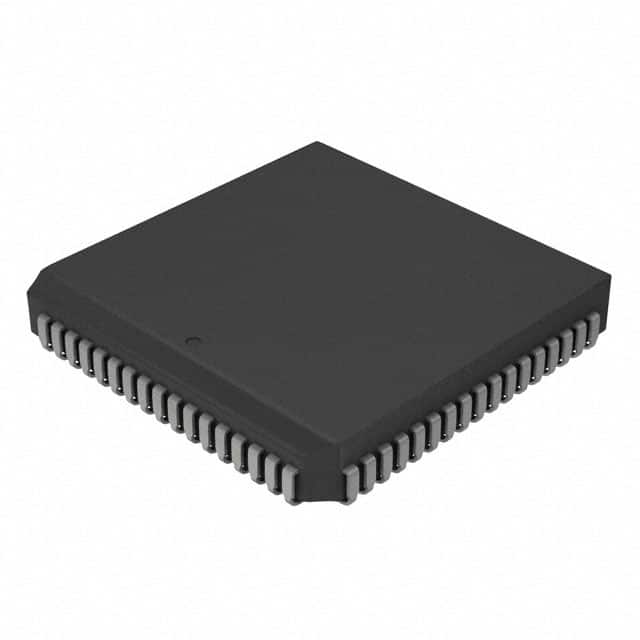Viz Specifikace pro podrobnosti o produktu.

PIC17C766-16I/L
Product Overview
Category
The PIC17C766-16I/L belongs to the category of microcontrollers.
Use
This microcontroller is commonly used in various electronic devices and embedded systems for controlling and processing data.
Characteristics
- High-performance 8-bit microcontroller
- Low power consumption
- Enhanced features for efficient data processing
- Wide operating voltage range
- Robust design for reliable operation in harsh environments
Package
The PIC17C766-16I/L is available in a compact and durable package, suitable for surface mount technology (SMT) applications.
Essence
The essence of the PIC17C766-16I/L lies in its ability to provide advanced control and processing capabilities in a small form factor, making it ideal for space-constrained applications.
Packaging/Quantity
This microcontroller is typically packaged in reels or tubes, with quantities varying based on customer requirements.
Specifications
- Architecture: 8-bit RISC
- CPU Speed: 16 MHz
- Program Memory Size: 32 KB Flash
- RAM Size: 2 KB
- Number of I/O Pins: 36
- Operating Voltage Range: 2.5V - 5.5V
- Operating Temperature Range: -40°C to +85°C
- Communication Interfaces: UART, SPI, I2C
- Timers/Counters: 3 x 8-bit, 1 x 16-bit
- Analog-to-Digital Converter (ADC): 10-bit, 8 channels
Detailed Pin Configuration
The PIC17C766-16I/L has a total of 44 pins, each serving a specific purpose. The pin configuration is as follows:
- VDD: Power supply voltage
- VSS: Ground
- RA0 - RA7: General-purpose I/O pins
- RB0 - RB7: General-purpose I/O pins
- RC0 - RC7: General-purpose I/O pins
- RD0 - RD7: General-purpose I/O pins
- RE0 - RE3: General-purpose I/O pins
- MCLR: Master Clear input
- OSC1/CLKIN: Oscillator input
- OSC2/CLKOUT: Oscillator output
- VREF-: Negative reference voltage for ADC
- VREF+: Positive reference voltage for ADC
- AN0 - AN7: Analog input pins for ADC
Functional Features
The PIC17C766-16I/L offers a range of functional features, including:
- High-speed processing capabilities
- Flexible I/O configurations
- Multiple communication interfaces for data exchange
- Built-in timers and counters for precise timing operations
- Analog-to-digital conversion for sensor interfacing
- Enhanced interrupt handling for real-time responsiveness
- Low power consumption modes for energy efficiency
Advantages and Disadvantages
Advantages
- Compact size and low power consumption make it suitable for portable devices
- Wide operating voltage range allows for compatibility with various power sources
- Robust design ensures reliable operation in challenging environments
- Rich set of integrated peripherals simplifies system design and reduces external component count
Disadvantages
- Limited program memory size may restrict the complexity of applications
- 8-bit architecture may not be sufficient for certain computationally intensive tasks
- Lack of advanced connectivity options like Ethernet or USB may limit networking capabilities
Working Principles
The PIC17C766-16I/L operates based on an 8-bit Reduced Instruction Set Computer (RISC) architecture. It executes instructions stored in its program memory to perform various tasks. The microcontroller interacts with external devices through its I/O pins and communication interfaces. It can process data, control peripherals, and respond to interrupts in real-time.
Detailed Application Field Plans
The PIC17C766-16I/L finds applications in a wide range of fields, including:
- Consumer Electronics: Used in smart home devices, remote controls, and wearable gadgets.
- Industrial Automation: Employed in control systems for machinery, robotics, and process automation.
- Automotive: Integrated into automotive electronics for engine management, dashboard displays, and safety systems.
- Medical Devices: Utilized in medical equipment such as patient monitors, infusion pumps, and diagnostic devices.
- Internet of Things (IoT): Enables connectivity and control in IoT devices like smart sensors, gateways, and actuators.
Detailed and Complete Alternative Models
- PIC18F4550: 8-bit microcontroller with USB connectivity and larger program memory.
- ATmega328P: Popular 8-bit microcontroller from Atmel with a rich set of peripherals.
- STM32F103C8T6: 32-bit ARM Cortex-M3 microcontroller with extensive I/O capabilities.
- MSP430G2553: Ultra-low-power microcontroller suitable for battery-powered applications. 5
Seznam 10 běžných otázek a odpovědí souvisejících s aplikací PIC17C766-16I/L v technických řešeních
What is the operating voltage range of PIC17C766-16I/L?
- The operating voltage range of PIC17C766-16I/L is 4.5V to 5.5V.What is the maximum clock frequency supported by PIC17C766-16I/L?
- PIC17C766-16I/L supports a maximum clock frequency of 16 MHz.Can PIC17C766-16I/L be used for motor control applications?
- Yes, PIC17C766-16I/L can be used for motor control applications with appropriate interfacing and programming.Does PIC17C766-16I/L have built-in analog-to-digital converters (ADC)?
- No, PIC17C766-16I/L does not have built-in ADCs.What are the communication interfaces supported by PIC17C766-16I/L?
- PIC17C766-16I/L supports UART, SPI, and I2C communication interfaces.Is PIC17C766-16I/L suitable for battery-powered applications?
- Yes, PIC17C766-16I/L is suitable for battery-powered applications due to its low power consumption.Can PIC17C766-16I/L be programmed using C language?
- Yes, PIC17C766-16I/L can be programmed using C language with appropriate compilers and development tools.What are the available memory options in PIC17C766-16I/L?
- PIC17C766-16I/L has 8KB of program memory and 368 bytes of data memory.Is PIC17C766-16I/L suitable for industrial control applications?
- Yes, PIC17C766-16I/L is suitable for industrial control applications due to its robust features and reliability.Can PIC17C766-16I/L be used in automotive electronics?
- Yes, PIC17C766-16I/L can be used in automotive electronics with proper consideration of environmental conditions and standards compliance.

